否定句结构
- 格式:doc
- 大小:25.50 KB
- 文档页数:6
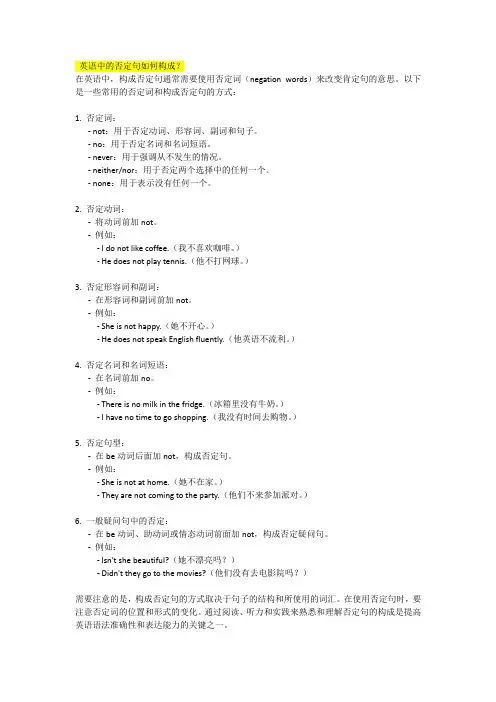
英语中的否定句如何构成?在英语中,构成否定句通常需要使用否定词(negation words)来改变肯定句的意思。
以下是一些常用的否定词和构成否定句的方式:1. 否定词:- not:用于否定动词、形容词、副词和句子。
- no:用于否定名词和名词短语。
- never:用于强调从不发生的情况。
- neither/nor:用于否定两个选择中的任何一个。
- none:用于表示没有任何一个。
2. 否定动词:-将动词前加not。
-例如:- I do not like coffee.(我不喜欢咖啡。
)- He does not play tennis.(他不打网球。
)3. 否定形容词和副词:-在形容词和副词前加not。
-例如:- She is not happy.(她不开心。
)- He does not speak English fluently.(他英语不流利。
)4. 否定名词和名词短语:-在名词前加no。
-例如:- There is no milk in the fridge.(冰箱里没有牛奶。
)- I have no time to go shopping.(我没有时间去购物。
)5. 否定句型:-在be动词后面加not,构成否定句。
-例如:- She is not at home.(她不在家。
)- They are not coming to the party.(他们不来参加派对。
)6. 一般疑问句中的否定:-在be动词、助动词或情态动词前面加not,构成否定疑问句。
-例如:- Isn't she beautiful?(她不漂亮吗?)- Didn't they go to the movies?(他们没有去电影院吗?)需要注意的是,构成否定句的方式取决于句子的结构和所使用的词汇。
在使用否定句时,要注意否定词的位置和形式的变化。
通过阅读、听力和实践来熟悉和理解否定句的构成是提高英语语法准确性和表达能力的关键之一。
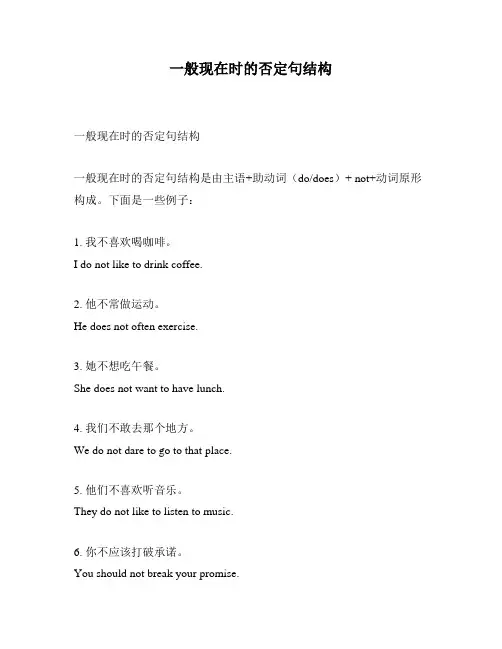
一般现在时的否定句结构一般现在时的否定句结构一般现在时的否定句结构是由主语+助动词(do/does)+ not+动词原形构成。
下面是一些例子:1. 我不喜欢喝咖啡。
I do not like to drink coffee.2. 他不常做运动。
He does not often exercise.3. 她不想吃午餐。
She does not want to have lunch.4. 我们不敢去那个地方。
We do not dare to go to that place.5. 他们不喜欢听音乐。
They do not like to listen to music.6. 你不应该打破承诺。
You should not break your promise.7. 她不知道如何做菜。
She does not know how to cook.8. 他们不在意别人的看法。
They do not care about what others think.9. 我们不需要太多的东西。
We do not need too many things.10. 他不会说汉语。
He does not speak Chinese.通过以上的例子,我们可以发现,一般现在时的否定句结构可以适用于各种时态,各种情况。
当我们需要表达否定的意思时,可以使用这种句子结构来进行表达。
同时,在使用这种句子结构时,要注意主语和助动词之间的契合性,以及动词原形的使用方式。
只有掌握了这些知识点,才能够在口语和写作中灵活地运用这种句子结构,提高表达的准确度和流畅度。
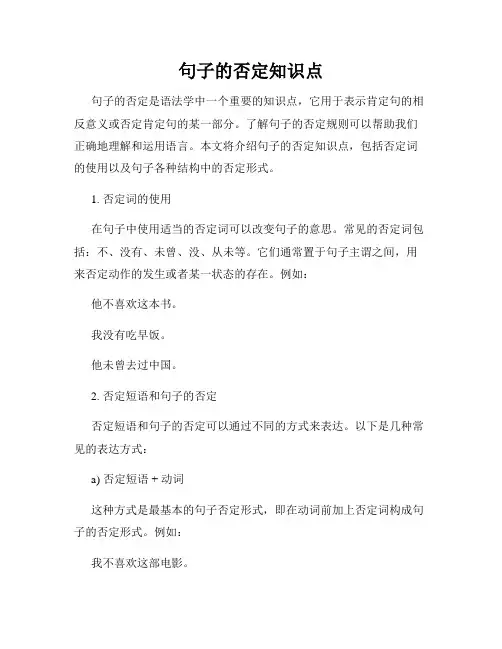
句子的否定知识点句子的否定是语法学中一个重要的知识点,它用于表示肯定句的相反意义或否定肯定句的某一部分。
了解句子的否定规则可以帮助我们正确地理解和运用语言。
本文将介绍句子的否定知识点,包括否定词的使用以及句子各种结构中的否定形式。
1. 否定词的使用在句子中使用适当的否定词可以改变句子的意思。
常见的否定词包括:不、没有、未曾、没、从未等。
它们通常置于句子主谓之间,用来否定动作的发生或者某一状态的存在。
例如:他不喜欢这本书。
我没有吃早饭。
他未曾去过中国。
2. 否定短语和句子的否定否定短语和句子的否定可以通过不同的方式来表达。
以下是几种常见的表达方式:a) 否定短语 + 动词这种方式是最基本的句子否定形式,即在动词前加上否定词构成句子的否定形式。
例如:我不喜欢这部电影。
他们没有参加聚会。
我从未见过他。
b) 否定短语 + 助动词在英语中,否定词通常与助动词连用,构成否定句的形式。
例如:她不能来参加聚会。
我们不会迟到。
我没有看过那部电影。
c) 否定短语 + be动词在表示某种状态或性质的句子中,可以使用否定词与be动词连用,来表示否定。
例如:这个房间里没有人。
我不是一个演员。
这个事情不重要。
3. 否定疑问句否定疑问句是一种特殊的疑问句,它用来向对方提出一个否定的问题,通常表示询问是否与肯定句的内容相反。
常见的否定疑问句结构为:肯定部分 + 否定疑问词 + 否定动词 + 否定内容。
例如:你不喜欢这本书,是吗?你没有去过中国,对吗?4. 否定副词的位置在一般情况下,否定副词一般放在动词之前,形容词或者副词之后。
然而,在特定情况下,否定副词的位置可能会发生改变,具体要根据句子结构和语境来决定。
例如:他绝不会这么做。
我永远不会忘记你。
这个问题你不能不回答。
总结:句子的否定是语法学中一个重要的知识点,它用来表示句子的相反意义或否定句的某一部分。
了解句子的否定规则可以帮助我们正确地理解和运用语言。
本文介绍了否定词的使用、否定短语和句子的否定形式、否定疑问句以及否定副词的位置等知识点。
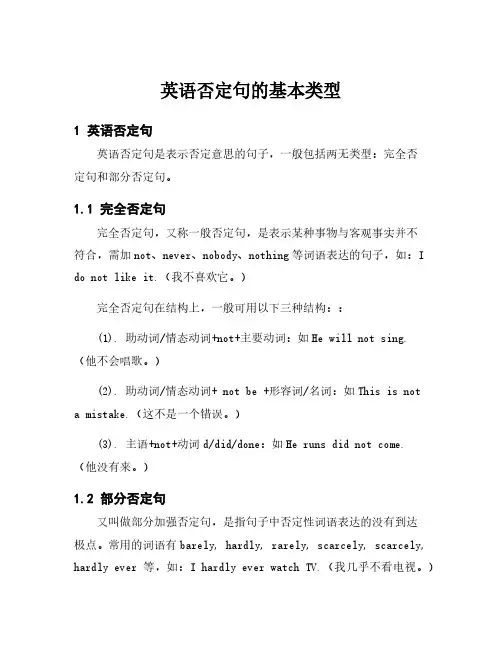
英语否定句的基本类型1 英语否定句英语否定句是表示否定意思的句子,一般包括两无类型:完全否定句和部分否定句。
1.1 完全否定句完全否定句,又称一般否定句,是表示某种事物与客观事实并不符合,需加not、never、nobody、nothing等词语表达的句子,如:I do not like it.(我不喜欢它。
)完全否定句在结构上,一般可用以下三种结构::(1). 助动词/情态动词+not+主要动词:如He will not sing.(他不会唱歌。
)(2). 助动词/情态动词+ not be +形容词/名词:如This is nota mistake.(这不是一个错误。
)(3). 主语+not+动词d/did/done:如He runs did not come.(他没有来。
)1.2 部分否定句又叫做部分加强否定句,是指句子中否定性词语表达的没有到达极点。
常用的词语有barely, hardly, rarely, scarcely, scarcely, hardly ever等,如:I hardly ever watch TV.(我几乎不看电视。
)部分否定句在结构上,也有三种:(1). 助动词/情态动词+hardly / scarcely/ rarely(almost不常用)+动词原形:如He can hardly speak English.(他几乎不会说英语。
)(2). 主语+hardly/scarcely/rarely(almost不常用)+动词过去式:如She rarely visited the park.(她很少去公园。
)(3). 主语+have/has+hardly/scarcely/rarely(almost不常用)+过去分词:如I have hardly taken the exam.(我几乎没参加过考试。
)以上就是英语中完全否定句和部分否定句的基本类型,当然还有很多否定句的表达方式,都是因人而异。
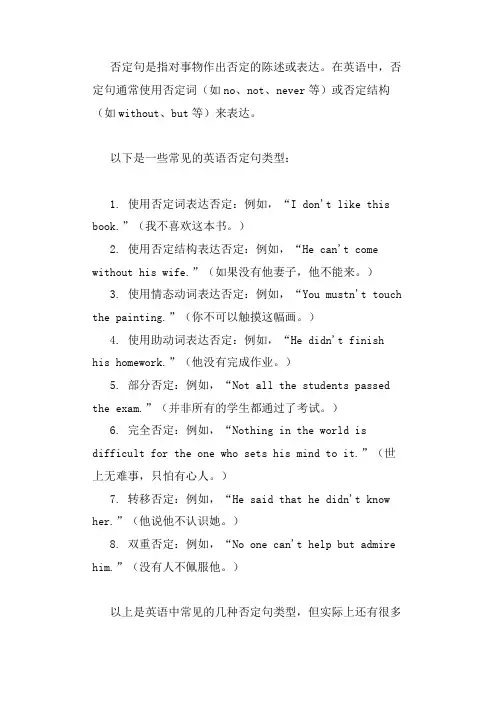
否定句是指对事物作出否定的陈述或表达。
在英语中,否定句通常使用否定词(如no、not、never等)或否定结构(如without、but等)来表达。
以下是一些常见的英语否定句类型:
1. 使用否定词表达否定:例如,“I don't like this book.”(我不喜欢这本书。
)
2. 使用否定结构表达否定:例如,“He can't come without his wife.”(如果没有他妻子,他不能来。
)
3. 使用情态动词表达否定:例如,“You mustn't touch the painting.”(你不可以触摸这幅画。
)
4. 使用助动词表达否定:例如,“He didn't finish his homework.”(他没有完成作业。
)
5. 部分否定:例如,“Not all the students passed the exam.”(并非所有的学生都通过了考试。
)
6. 完全否定:例如,“Nothing in the world is
diff icult for the one who sets his mind to it.”(世上无难事,只怕有心人。
)
7. 转移否定:例如,“He said that he didn't know her.”(他说他不认识她。
)
8. 双重否定:例如,“No one can't help but admire him.”(没有人不佩服他。
)
以上是英语中常见的几种否定句类型,但实际上还有很多
其他的表达方式。
在具体语境中,需要根据具体情况选择合适的表达方式。
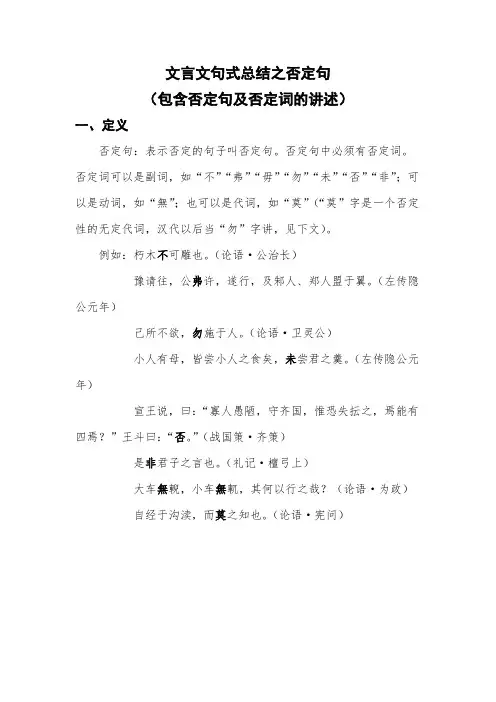
文言文句式总结之否定句(包含否定句及否定词的讲述)一、定义否定句:表示否定的句子叫否定句。
否定句中必须有否定词。
否定词可以是副词,如“不”“弗”“毋”“勿”“未”“否”“非”;可以是动词,如“無”;也可以是代词,如“莫”(“莫”字是一个否定性的无定代词,汉代以后当“勿”字讲,见下文)。
例如:朽木不可雕也。
(论语·公治长)豫请往,公弗许,遂行,及邾人、郑人盟于翼。
(左传隐公元年)己所不欲,勿施于人。
(论语·卫灵公)小人有母,皆尝小人之食矣,未尝君之羹。
(左传隐公元年)宣王说,曰:“寡人愚陋,守齐国,惟恐失抎之,焉能有四焉?”王斗曰:“否。
”(战国策·齐策)是非君子之言也。
(礼记·檀弓上)大车無輗,小车無軏,其何以行之哉?(论语·为政)自经于沟渎,而莫之知也。
(论语·宪问)二、否定句的两类结构1、在文言文中,用“不”“毋”“未”“莫”四个否定词的否定句有一个特点:如果宾语是一个代词,一般总是放在动词的前面。
例如:居则曰:“不吾知也。
”(论语·先进)我無尔诈,尔無我虞。
(左传宣公十五年)大道之行也,与三代之英,丘未之逮也。
(礼记·礼运)谏而不入,则莫之继也。
(左传宣公二年)在第一个例子里,“吾”是“知”的宾语,放在“知”的前面,现代汉语却只能说“不知道我”(不了解我)。
其余由此类推。
有人把上面所举的这类句子叫做倒装句,那是不对的。
在文言文里,这是最正常的结构,而不是“倒装”。
这个规律在用否定词“未”“莫”的句子里最为严格,很少例外。
直到后代,由于仿古的关系,古文家仍然运用这个结构。
2、至于用“弗”“勿”“非”“無”四个否定词的否定句,就不能运用这个结构了,这是因为“弗”“勿”所限制的动词一般不带宾语(见下文),“非”字是否定整个谓语的,而“無”字本身就是动词。
从宾语来看,如果宾语不是代词,即使是否定句也不能用这种结构。
“君”“子”一类的字不是真正的代词,也不能用这种结构。
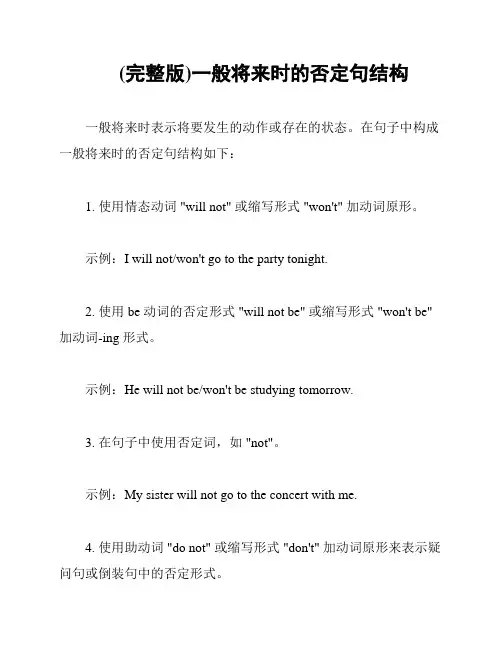
(完整版)一般将来时的否定句结构一般将来时表示将要发生的动作或存在的状态。
在句子中构成一般将来时的否定句结构如下:1. 使用情态动词 "will not" 或缩写形式 "won't" 加动词原形。
示例:I will not/won't go to the party tonight.2. 使用 be 动词的否定形式 "will not be" 或缩写形式 "won't be" 加动词-ing 形式。
示例:He will not be/won't be studying tomorrow.3. 在句子中使用否定词,如 "not"。
示例:My sister will not go to the concert with me.4. 使用助动词 "do not" 或缩写形式 "don't" 加动词原形来表示疑问句或倒装句中的否定形式。
示例:Will you not/don't play football tomorrow?需要注意的是,当句子使用 "be going to" 来表示将来时,否定句的结构与一般将来时的否定句结构相似。
示例:I am not going to travel next week.总结一下,一般将来时的否定句结构包括情态动词 "will" 或"be going to" 的否定形式,否定词 "not" 和动词原形或动词-ing 形式的组合。
根据具体的语境和句子结构,选择合适的否定句结构来表达未来否定的动作或状态。

英语中的基本否定句结构英语中的基本否定句结构主要由否定副词或动词构成,用于表达否定的意思。
在下面的文档中,我们将讨论英语中基本的否定句结构,以帮助您更好地理解和使用它们。
1. 否定副词的使用否定副词在句子中起到否定动词或句子的作用。
常见的否定副词有以下几种:- not:在句子中通常用来否定动词。
例如:“I do not like coffee.”(我不喜欢咖啡。
)not:在句子中通常用来否定动词。
例如:“I do not like coffee.”(我不喜欢咖啡。
)not:在句子中通常用来否定动词。
例如:“I do not like coffee.”(我不喜欢咖啡。
)- never:表示从来没有发生或不会发生的意思。
例如:“She never goes to the gym.”(她从不去健身房。
)never:表示从来没有发生或不会发生的意思。
例如:“She never goes to the gym.”(她从不去健身房。
)never:表示从来没有发生或不会发生的意思。
例如:“She never goes to the gym.”(她从不去健身房。
)- no:用来否定名词。
例如:“There is no milk in the fridge.”(冰箱里没有牛奶。
)no:用来否定名词。
例如:“There is no milk in the fridge.”(冰箱里没有牛奶。
)no:用来否定名词。
例如:“There is no milk in the fridge.”(冰箱里没有牛奶。
)2. 否定动词的使用除了否定副词,否定动词也常用于构成否定句。
以下是一些常见的否定动词:- do not:用于否定一般现在时和一般过去时的动词。
例如:“They do not play basketball.”(他们不打篮球。
)do not:用于否定一般现在时和一般过去时的动词。
例如:“They do not play basketball.”(他们不打篮球。
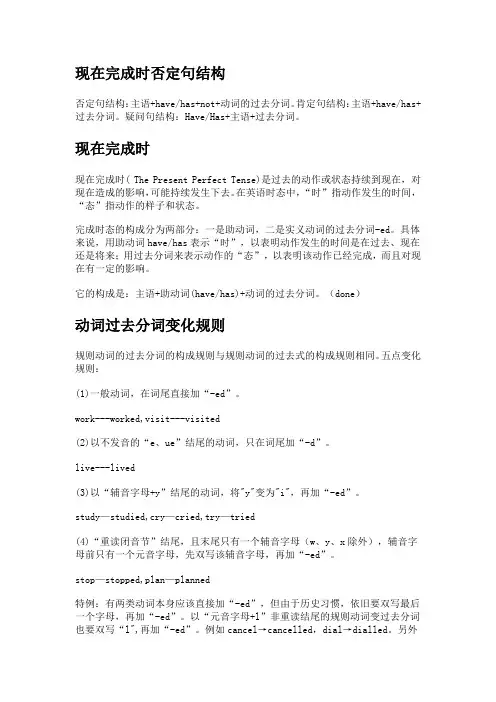
现在完成时否定句结构 否定句结构:主语+have/has+not+动词的过去分词。肯定句结构:主语+have/has+过去分词。疑问句结构:Have/Has+主语+过去分词。
现在完成时 现在完成时( The Present Perfect Tense)是过去的动作或状态持续到现在,对现在造成的影响,可能持续发生下去。在英语时态中,“时”指动作发生的时间,“态”指动作的样子和状态。
完成时态的构成分为两部分:一是助动词,二是实义动词的过去分词-ed。具体来说,用助动词have/has表示“时”,以表明动作发生的时间是在过去、现在还是将来;用过去分词来表示动作的“态”,以表明该动作已经完成,而且对现在有一定的影响。
它的构成是:主语+助动词(have/has)+动词的过去分词。(done) 动词过去分词变化规则 规则动词的过去分词的构成规则与规则动词的过去式的构成规则相同。五点变化规则:
(1)一般动词,在词尾直接加“-ed”。 work---worked,visit---visited (2)以不发音的“e、ue”结尾的动词,只在词尾加“-d”。 live---lived (3)以“辅音字母+y”结尾的动词,将"y"变为"i",再加“-ed”。 study—studied,cry—cried,try—tried (4)“重读闭音节”结尾,且末尾只有一个辅音字母(w、y、x除外),辅音字母前只有一个元音字母,先双写该辅音字母,再加“-ed”。
stop—stopped,plan—planned 特例:有两类动词本身应该直接加“-ed”,但由于历史习惯,依旧要双写最后一个字母,再加“-ed”。以“元音字母+l”非重读结尾的规则动词变过去分词也要双写“l",再加“-ed”。例如cancel→cancelled,dial→dialled。另外还有一些以非重读闭音节结尾的规则动词变过去分词也要双写最后一个辅音字母,再加“-ed”。例如:kidnap→kidnapped,worship→worshipped。而上述两种情况在美国一般却直接加“-ed”。

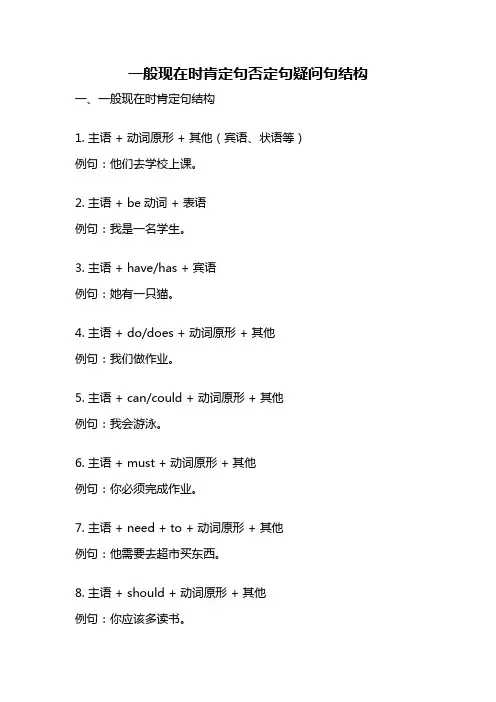
一般现在时肯定句否定句疑问句结构一、一般现在时肯定句结构1. 主语 + 动词原形 + 其他(宾语、状语等)例句:他们去学校上课。
2. 主语 + be动词 + 表语例句:我是一名学生。
3. 主语 + have/has + 宾语例句:她有一只猫。
4. 主语 + do/does + 动词原形 + 其他例句:我们做作业。
5. 主语 + can/could + 动词原形 + 其他例句:我会游泳。
6. 主语 + must + 动词原形 + 其他例句:你必须完成作业。
7. 主语 + need + to + 动词原形 + 其他例句:他需要去超市买东西。
8. 主语 + should + 动词原形 + 其他例句:你应该多读书。
9. 主语 + would + 动词原形 + 其他例句:我愿意帮助你。
10. 主语 + will + 动词原形 + 其他例句:他明天会来参加聚会。
二、一般现在时否定句结构1. 主语 + do not/does not + 动词原形 + 其他例句:他们不喜欢吃蔬菜。
2. 主语 + am not/is not/are not + 表语例句:我不是一个演员。
3. 主语 + have/has + not + 宾语例句:她没有一本好书。
4. 主语 + can't/couldn't + 动词原形 + 其他例句:我不能去参加聚会。
5. 主语 + must not + 动词原形 + 其他例句:你不能迟到。
6. 主语 + need + not + to + 动词原形 + 其他例句:他不需要帮助。
7. 主语 + should not + 动词原形 + 其他例句:你不应该浪费时间。
8. 主语 + would not + 动词原形 + 其他例句:我不会告诉他。
9. 主语 + will not + 动词原形 + 其他例句:他不会来参加聚会。
10. 主语 + am/are/is + not + 动词-ing + 其他例句:我不在听音乐。
否定句的构成与否定副词的运用否定句是指通过添加否定副词或其他否定语气词来对陈述句作出否定的句子结构。
否定副词在英语中起着非常重要的作用,能够改变句子的意思。
本文将介绍否定句的构成以及否定副词的运用,以帮助读者更好地理解和运用否定句结构。
一、否定句的构成在英语中,构成否定句的方式有多种。
最常见的方式是在动词前面加上否定副词,例如"don't"和"doesn't"。
此外,还可以使用其他助动词来构成否定句,如"can't"、"won't"、"isn't"等。
1. 否定副词 + 动词例如:- I don't like coffee.(我不喜欢咖啡。
)- She doesn't play tennis.(她不打网球。
)2. 助动词 + 否定副词 + 动词例如:- He can't swim.(他不会游泳。
)- We won't go to the party.(我们不去参加聚会。
)3. 助动词 + not + 动词例如:- They haven't finished their homework yet.(他们还没做完功课。
)- He isn't coming to the meeting.(他不会参加会议。
)需要注意的是,动词be的否定形式是通过在be动词后面直接加not 来构成,如"is not"缩写为"isn't","are not"缩写为"aren't"。
二、否定副词的运用否定副词在构成否定句中起着关键作用。
在不同的情况下,我们会使用不同的否定副词。
1. "not"的使用"not"是构成否定句最常见的否定副词,它放在动词前面来表达否定意义。
.
精品
一、全部否定
全部否定通常由含有全部否定意义的词,如 no, none, nobody, nowhere, no
one, never, neither, nor 等加上表示肯定意义的谓语动词构成。例如:
1. We couldn't eat in a restaurant because ____ of us had ___ money on
us.(MET1991)
A. all; no B. any; no C. none; any D. on one; any
析:根据句意“我们不能在餐馆吃饭”,可推测后句为“因为我们谁也没带
钱”。 no one 虽能表示全部否定,但其后不能跟 of 短语。所以该题选 C 。
类似试题:
(1)They were all tired, but ____ of them would stop to take a rest.(NMET1995)
A. any B. some C. none D. neither
(2)Both teams were in hard training; ____ was willing to lose the game. (上海
2001 )
A. either B. neither C. another D. the other
注意:“否定谓语 + 不定代词 any/either 等”也可构成全部否定。例如:
We won't buy any of the books. 我们不会买任何一本书。
.
精品
二、部分否定
部分否定是由表示总括意义的词如 all, both, every, each, everything, everybody
以及 always, completely, entirely, wholly 等加上否定词 not, never 等构成的,含有
“不全是、并非都”等意思。例如:
I agree with most of what you said, but I don't agree with___. (NMET1997)
A. everything B. anything C. something D. nothing
析:由前一句“你说的我绝大部分同意”可推知后半句应为“但我并不是每
一个细节都同意”。在所给的四个选项中只有 everything 与 not 连用才能构成
部分否定。故选 A 。再如:
All that glitters is not gold. (莎士比亚语) =Not all that glitters is gold. 闪闪发
光的未必都是金子。
三、延续否定
延续否定是在前文否定的基础上,再追加一个或数个否定的句子或结构,以
补充说明已经否定的人或物的情况。其结构为“否定句 +neither/nor+ 助动词 +
主语 + ……”,或者是“ not … or …”等。例如:
1. — Do you know Jim quarreled with his brother?
— I don't know and ____. (MET1991)
.
精品
A. nor don't I care B. nor do I care C. I don't care, neither D. I don't care also
析: I don't know 已是一个否定句,而后面又紧跟一个否定句,进一步说明
主语的态度,整句意为:我不知道,也不关心。答案为 B 。
2. — I don't like chicken____ fish.
— I don't like chicken, _____ I like fish very much.(MET1993)
A. and; and B. and; but C. or; and D. or; but
析:当同时否定两者时,若重复否定词,则用 and 连接,如: I like no chicken
and no fish. 若只在前边加否定词,则用 or 连接。由于后一句不是延续否定,故
使用 but 表示转折。答案为 D 。
四、半(部分)否定
当句中出现含有否定意义的词,如 little, few, seldom, rarely, scarcely, hardly,
barely 等时,该句就构成半否定句;当这些半否定词置于句首时要采取部分倒装。
例如:
• Little____ about his own safety, though he was in great danger. (上海 1994 )
A. does he care B. did he care C. he cares D. he cared
析:表否定意义的词 little, never, seldom, hardly 等用于句首时句子要倒装。
根据语境,此处应该用过去时态。答案为 B 。
.
精品
2.____ got into the room, ____ the telephone rang. (MET1988)
A. He hardly had; then B. Hardly had he; when
C. He had not; than D. Not had he; when
析: hardly … when …是个常见句型,意为“一……就……”。当 hardly 位
于句首时句子也应倒装,但 hardly 也可放在句中,这时不倒装,即: He had hardly
got into the room when the telephone rang. 答案为 B 。
五、否定转移
当主句中含有动词 think, believe, expect, feel, guess, imagine, suppose 等时,其
后宾语从句的否定词往往转移到主句的谓语动词上。如: I don't think he is right.
(我认为他不对。)从近年高考试题来看重点在于考查一些简略答语中的否定转
移问题。例如:
1. — Do you think it's going to rain over the weekend?
— ______.(NMET1994)
A. I don't believe B. I don't believe it C. I believe not so D. I believe not
析:此题考查的是表达个人看法时的日常交际用语,肯定回答为: I believe
so 否定回答有两种: I believe not. 或 I don't believe so. 答案为 D 。
2. — The boys are not doing a good job at all, are they?
.
精品
— ____. (北京 2003 春招)
A. I guess not so B. I don't guess C. I don't guess so D. I guess not
析:根据习惯, guess, hope, be afraid 的否定答语只有一种形式,即: I
guess/hope/am afraid not. 而不能说: I don't guess/hope so. 也就是说这几个词不
能否定转移。答案为 D 。
六、特指否定
含有非谓语动词否定形式的句子,叫作特指否定句,其否定形式是在其前加
not/never. 例如:
1. Tom kept quiet about the accident _____ lose the job.(MET1990)
A. so not as to B. so as not to
C. so as to not D. not so as to
析: so as to do sth. 表目的时相当于 in order to do sth,其否定式为 so as not
to do sth. 。答案为 B 。
2. Mrs. Smith warned her daughter _____ after drinking.(MET1991)
A. never to drive B. to never drive
C. never driving D. never drive
.
精品
析: warn 后接不定式作补语,“警告某人不要干某事”应说: warn sb. not
to do sth.。答案为 A 。
3.______ a reply, he decided to write again. (MET1992)
A. Not receiving B. Receiving not
C. Not having received D. Having not received
析:根据语境可知,“没收到答复”先于谓语“决定再写”,故排除 A 。
答案为 C 。
另外,还有双重否定句等。例如:
______ he comes, we won't be able to go.
A. Without B. Unless
C. Except D. Even
析:此题选择 B 构成双重否定,全句意为“除非他来,否则我们不能走。”
当然,高考涉及否定的题目还有很多,限于篇幅,在此不再一一赘述。
如有侵权请联系告知删除,感谢你们的配合!